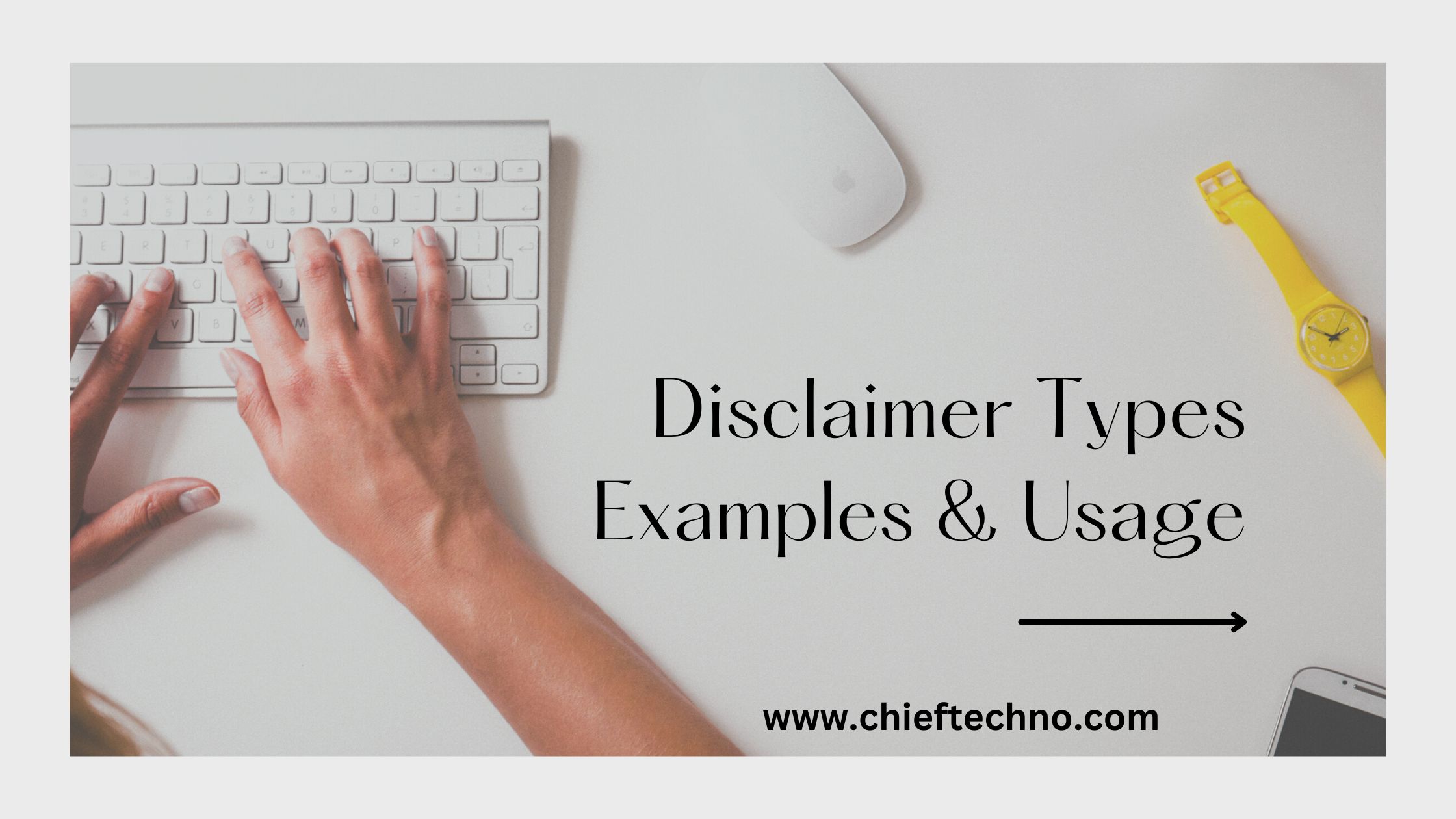What are common website disclaimer types & usages?
A disclaimer is a legally required statement that is included at the bottom of your website’s pages to inform readers about its contents. A disclaimer is not a legal requirement, but it’s an important part of content marketing strategy if you want to avoid potential liability issues. In this article, we’ll take a look at some common disclaimers types used on websites!
Why do I need a disclaimer?
A disclaimer is a legal document that you need to place on your website, blog or social media account. It’s often used in conjunction with a privacy policy and terms of service agreement (TOS), but can also be used by itself.
The purpose of disclaimers is to inform visitors about what information they may find on your site and how it will be used by you, so that visitors can make informed decisions about whether or not they want their personal data shared with third parties like advertisers or analytics companies.
Types of Disclaimer
When a disclaimer is used on your website, it’s important for you to know what type of disclaimer it is and how it will affect the way visitors perceive your content. Here are some common types:
1. General Disclaimer
A general disclaimer is a statement that provides information about the content of your website and the identity of its owner. It should be written in plain language, without any legal jargon or acronyms. A general disclaimer should also include contact information for your company—this will help you quickly respond to any questions or concerns people might have about what they’re reading on your site.
2. Affiliate Disclaimer
An affiliate disclaimer is a type of disclaimer that is used to inform visitors that the website is an affiliate site. An affiliate site is a site that earns a commission for each visitor or sale it sends to another company.
3. Medical Disclaimer
A medical disclaimer is a legal statement that you make to your website visitors. It explains any potential risks or side effects associated with using your product or service, as well as any interactions with other medications, substances or activities that could be dangerous for the user.
For example: “This product may cause drowsiness and dizziness. Do not drive if you feel drowsy or dizzy.”
You can also include information about minor warning signs that might indicate an underlying condition—such as an allergic reaction—that has been diagnosed by a physician but not yet reported on the label itself (in which case it’s still considered a medical disclaimer).
4. External Links Disclaimer
An external links disclaimer is a notice that appears on the page where you place it. It warns visitors that they may be linking to websites that contain content or information that is not owned by the person who provides them with the link.
An example of this disclaimer would be: “This blog post contains links to other sites.”
5. Warranty Disclaimer
Warranty disclaimers are used to inform users that the website is not liable for any damages that may occur. The warranty disclaimer should be placed in a visible area on the website, such as at the top or bottom of each page. It should also be easy to understand and use so it doesn’t confuse visitors who are looking for information about your product or service. If you have multiple pages on your site, each page should have its own separate warranty disclaimer statement, which helps ensure that all relevant information is accessible when someone views any given page.
6. Terms and Conditions Disclaimer
A terms and conditions disclaimer is a legal document that must be included on every page of your website. It explains what visitors should expect when they come to your site, including whether they can upload content or make purchases.
A good example of a terms and condition statement would be this one: “By visiting this web site, you understand that any information provided by users will not necessarily be reviewed by us prior to publication.” This type of language allows for flexibility in how you present information about your business model and policies without alienating potential customers who may have questions about certain aspects of the site’s operations.
7. Copyright Disclaimer
Copyright is a form of legal protection provided for original works of authorship, including literary, dramatic, musical, artistic and other intellectual works. Copyright does not protect facts or ideas but it may protect the way they are expressed.
Copyright protects artworks such as paintings that are fixed in a tangible medium like paint on canvas or chalk on blackboard (though this is not always the case). Examples include the works of Shakespeare; many pieces by Picasso; Rumi’s poetry; Chopin’s piano music etc…
8. Product Disclaimer
Product disclaimers are used to protect your business from lawsuits. If you sell a product, then it’s important that you have a disclaimer on your website so that customers know what they are buying and how it might affect them in the future. For example, if you sell an anti-aging cream that promises to make someone look 10 years younger in just three days, then having an explicit disclaimer about possible side effects can help prevent any misunderstandings or lawsuits down the road.
Another reason why product disclaimers are important is because they inform customers of potential risks associated with using their products—and this information should be disclosed before buying anything at all! It could also explain any potential interactions between body chemistry and certain ingredients found in some medications that may cause serious side effects if taken together (e.g., taking ibuprofen while taking birth control pills).
9. Legal Disclaimers
A disclaimer is a legally required statement that is included at the beginning of a document (e.g., on the front page of your website) to inform readers about its contents. A disclaimer is not a legal requirement, but it’s an important part of content marketing strategy if you want to avoid potential liability issues. In this article, we’ll take a look at some common types of disclaimers used on websites!
10. Liability Disclaimers
The next type of disclaimer is the disclaimer of liability. This type of disclaimer states that the website owner is not responsible for any damages that may occur as a result of using the website, but it does not limit the website owner’s liability. This type of disclaimer is usually used when the website owner is aware of the potential for damage but does not want to be held liable for it.
Conclusion
We hope that our article has given you some tips to consider when deciding on which type of disclaimer is best for your website. If you have any questions or comments, please let us know!
FAQ
How do website disclaimers work?
Website disclaimers are statements that are placed on a website that indicate that the information on the website is not authoritative and should not be treated as such. They typically appear at the bottom of a website’s home page or in the footer of a website.
What are the benefits of using website disclaimers?
Disclaimers can be a helpful way to protect your brand and business from potential lawsuits. By clearly stating that information on your website is not verified or endorsed by you, you can avoid potential legal issues. Additionally, disclaimers can help you attract new customers and boost your credibility.
How do I make sure my website disclaimer is effective?
There is no one-size-fits-all answer to this question, as the effectiveness of a disclaimer will vary depending on the nature and content of the website in question. However, some tips on how to make sure your disclaimer is effective include using clear and concise language, ensuring that it is prominently displayed on the website, and incorporating disclaimers into the website’s content in a way that is both relevant and understandable.
How do I insert a website disclaimer on my website?
To insert a disclaimer on your website, follow these steps:
1. Log in to your website’s admin panel.
2. Click on “Pages” in the left column.
3. On the right column, click on “Add a new page.”
4. Type in the URL of the disclaimer you’d like to add and click on “OK.”
5. Add the disclaimer text and hit “Save.
What should I do if I don’t have website disclaimers?
If you don’t have website disclaimers, you should consider creating them. Disclaimers can help protect your website and its content from being used without your consent or permission. You can create a disclaimer by following these steps: – Go to Google and type ” website disclaimer template” into the search bar. – Once you find a suitable disclaimer template, open it in your web browser. – In the disclaimer, you’ll need to include the following information: – Your website’s URL – The name of the person or company that created the disclaimer – The date the disclaimer was created – The disclaimer is legally binding and must be displayed on every page of your website.










